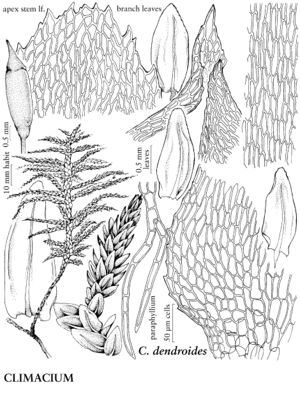Climacium dendroides
in F. Weber, Naturh. Reise Schweden, 96. 1804.
Plants dark green to yellowish, glossy when dry. Stem leaves with apex obtuse, often abruptly apiculate; laminal cells near insertion with walls thin, not porose. Branch leaves with base not or somewhat auriculate; apex obtuse; medial laminal cells (6–)7–13:1. Capsule shortly oblong-cylindric, 1.5–3(–4) mm.
Phenology: Capsules mature fall.
Habitat: Mesic or hydric microhabitats, along and in streams, margins of ponds and lakes, swamps, fens, seepages, upland depressions, organic substrates
Elevation: low to high elevations
Distribution

Greenland, Alta., B.C., Man., N.B., Nfld. and Labr., N.W.T., N.S., Nunavut, Ont., P.E.I., Que., Sask., Yukon, Alaska, Ariz., Calif., Colo., Conn., Idaho, Ill., Iowa, Maine, Mass., Mich., Minn., Mont., N.H., N.J., N.Mex., N.Y., N.C., N.Dak., Oreg., Pa., S.Dak., Utah, Vt., Va., Wash., Wis., Wyo., Mexico (Veracruz), Eurasia, Atlantic Islands (Iceland), Pacific Islands (New Zealand), Australia.
Discussion
The stem leaves of Climacium dendroides have been described as often apiculate, and those of C. americanum as gradually acute-acuminate, but this character often will not differentiate the species, as both commonly have apiculate stem leaves. The stem and branch leaves of C. dendroides are mostly obtuse and apiculate; in C. americanum they are mostly acute, irrespective of the presence of an apiculus. Branch leaf apical cells of C. dendroides, distal to the last pair of large teeth, generally extend even with the last pair, hence the whole apex obtuse in outline; apical cells of C. americanum extend beyond the last pair of large teeth and form a distinctly acute triangular area. In C. dendroides, the basal angles of stem and branch leaves are flat, continuous with the leaf outline, sharply rounded-cordate, and may appear auriculate due to a sinuate flexion of the margins. In C. americanum, auriculate alar regions are sharply and abruptly differentiated from the leaf outline. In C. dendroides, the stem and branch leaves often have hyaline, thin-walled, lax, abruptly inflated and enlarged cells at the basal angles, whereas in C. americanum the cells near the basal angles are quadrate and concolorous.
Selected References
None.
